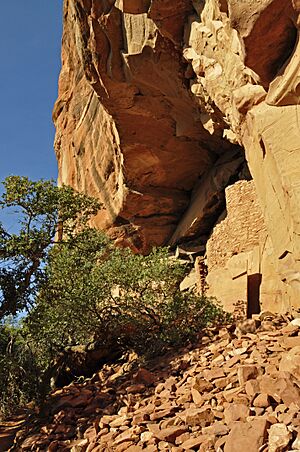Honanki facts for kids

The Honanki Heritage Site is an amazing place in the Coconino National Forest in Arizona. It's about 15 miles (24 km) west of Sedona. Here, you can see ancient cliff dwellings and incredible rock art. The Sinagua people, who were ancestors of today's Hopi people, lived here a long time ago, from about 1100 to 1300 AD. Another similar site, the Palatki Heritage Site, is also nearby.
A Look Back in Time
Who Lived Here?
Long ago, the Honanki and Palatki sites were first explored by a scientist named Jesse Walter Fewkes from the Smithsonian Institution. He started digging there in 1895 and again in 1911. He was studying the stories of how the Hopi people moved around. Fewkes gave the site its name, "Honanki," which means "Bear House" in the Hopi language.
Honanki was one of the biggest ancient villages in the Verde Valley. The time when the Sinagua people lived here is even called the "Honanki Phase." Many of the cliff homes in the area near Sedona were used during this time. The Sinagua people likely lived at Honanki between 1130 and 1280 CE. Scientists know this from a tree-ring date of 1271 from a wooden beam found at the site.
Building and Art
Some of the rooms at the east end of Honanki were destroyed in a big fire. After the fire, the Sinagua people reused the stones to build new rooms. This shows that the site was built and changed at least three different times.
One of the most special things about Honanki is its pictographs. These are pictures painted on the rocks. Some of these pictographs are very old, even older than when the Sinagua people lived there, dating back to 2000 BCE. However, most of the pictographs were added by the Sinagua people between 900 and 1300 CE.
Later Inhabitants
After the Sinagua people, Honanki was also home to the Yavapai and Apache people. They also left their mark with pictographs. These later rock paintings date from about 1400 to 1875 CE.
Images for kids


